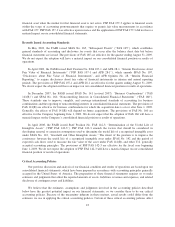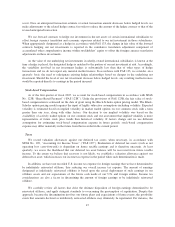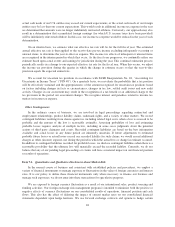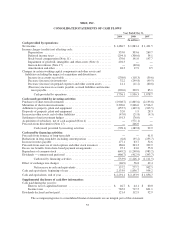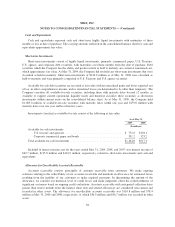Nike 2009 Annual Report Download - page 51
Download and view the complete annual report
Please find page 51 of the 2009 Nike annual report below. You can navigate through the pages in the report by either clicking on the pages listed below, or by using the keyword search tool below to find specific information within the annual report.anticipated but not yet firmly committed transactions as well as certain firm commitments and the related
receivables and payables, including third party and intercompany transactions. We also use forward contracts to
hedge our investment in the net assets of certain international subsidiaries to offset foreign currency translation
and economic exposures related to our net investment in those subsidiaries.
When we begin hedging exposures, the type and duration of each hedge depends on the nature of the
exposure and market conditions. Generally, all anticipated and firmly committed transactions that are hedged are
to be recognized within twelve to eighteen months, although at May 31, 2009 we had forward contracts hedging
anticipated transactions that will be recognized in as many as 23 months. The majority of the contracts expiring
in more than twelve months relate to the anticipated purchase of inventory by one of our European subsidiaries.
When intercompany loans are hedged, it is typically for their expected duration. Hedged transactions are
principally denominated in Euro, Japanese yen and British pound. See Section “Foreign Currency Exposures and
Hedging Practices” under Item 7 for additional detail.
Our earnings are also exposed to movements in short and long-term market interest rates. Our objective in
managing this interest rate exposure is to limit the impact of interest rate changes on earnings and cash flows and
to reduce overall borrowing costs. To achieve these objectives, we maintain a mix of commercial paper, bank
loans and fixed rate debt of varying maturities and have entered into receive-fixed, pay-variable interest rate
swaps.
Market Risk Measurement
We monitor foreign exchange risk, interest rate risk and related derivatives using a variety of techniques
including a review of market value, sensitivity analysis, and Value-at-Risk (“VaR”). Our market-sensitive
derivative and other financial instruments are foreign currency forward contracts, foreign currency option
contracts, interest rate swaps, intercompany loans denominated in non-functional currencies, fixed interest rate
U.S. dollar denominated debt, and fixed interest rate Japanese yen denominated debt.
We use VaR to monitor the foreign exchange risk of our foreign currency forward and foreign currency
option derivative instruments only. The VaR determines the maximum potential one-day loss in the fair value of
these foreign exchange rate-sensitive financial instruments. The VaR model estimates assume normal market
conditions and a 95% confidence level. There are various modeling techniques that can be used in the VaR
computation. Our computations are based on interrelationships between currencies and interest rates
(a “variance/co-variance” technique). These interrelationships are a function of foreign exchange currency
market changes and interest rate changes over the preceding one year period. The value of foreign currency
options does not change on a one-to-one basis with changes in the underlying currency rate. We adjusted the
potential loss in option value for the estimated sensitivity (the “delta” and “gamma”) to changes in the underlying
currency rate. This calculation reflects the impact of foreign currency rate fluctuations on the derivative
instruments only, and does not include the impact of such rate fluctuations on non-functional currency
transactions (such as anticipated transactions, firm commitments, cash balances, and accounts and loans
receivable and payable), including those which are hedged by these instruments.
The VaR model is a risk analysis tool and does not purport to represent actual losses in fair value that we
will incur, nor does it consider the potential effect of favorable changes in market rates. It also does not represent
the full extent of the possible loss that may occur. Actual future gains and losses will differ from those estimated
because of changes or differences in market rates and interrelationships, hedging instruments and hedge
percentages, timing and other factors.
The estimated maximum one-day loss in fair value on our foreign currency sensitive derivative financial
instruments, derived using the VaR model, was $67.8 million and $34.9 million at May 31, 2009 and May 31,
2008, respectively. The VaR increased, despite a reduction in the total notional value of our foreign currency
derivative instruments, as a result of increased foreign currency volatilities at May 31, 2009 as compared to
49






